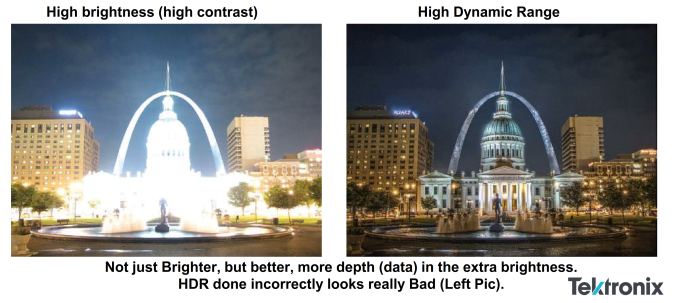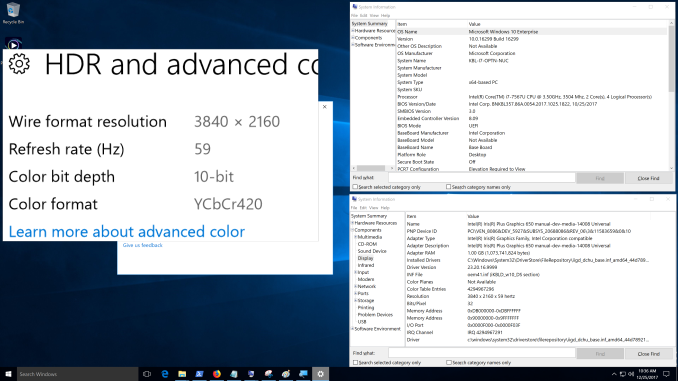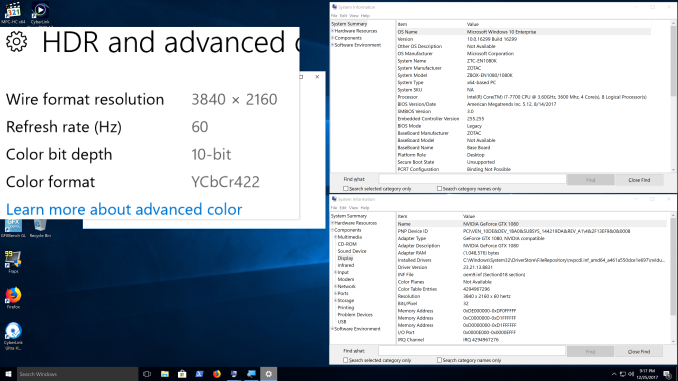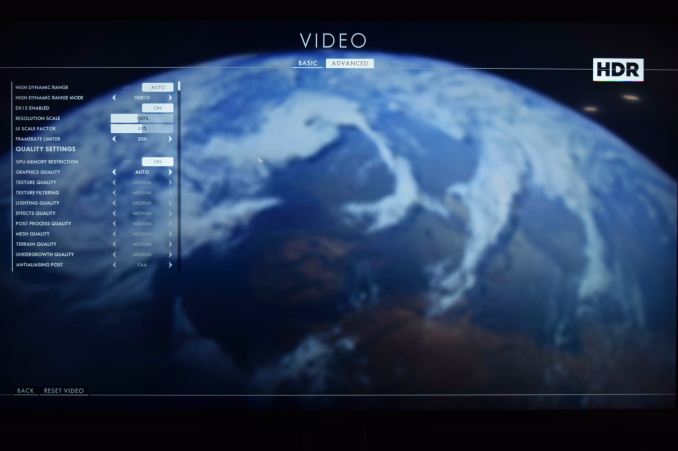A Budget Home Theater & PC Setup: 4K, HDR, UHD Blu-ray, and More
by Ganesh T S on December 26, 2017 8:30 AM ESTHDR Support
High Dynamic Range (HDR) is one of the most impressive features in the recent crop of 4K televisions. In layman's terms, it refers to the ability of a single frame to have wide variation in brightness for different regions. This allows the details in the dimly lit areas of the frame to be seen more clearly. Overall, it delivers a more vivid picture to the viewer. Note that this is quite different from the concept of high contrast.
Picture courtesy: SMPTE HDR Presentation from Steven Holmes of Tektronix
The ability of a display source to transmit HDR frames, as well as that of a display sink to be able to accept and understand them, can be gathered from the HDMI port's specifications. However, being able to accept and understand is only part of the problem. There are many low-cost 'fake HDR' TVs that simply parse the HDR information, but, do not have the ability to translate that to the display.
There are many HDR 'standards', with the base requirement being HDR10. Shifting a display sink into HDR mode involves the source sending some information (metadata) with the characteristics of the video being transported (the mapping of the pixel data to the displayed luminance, light levels in the video stream etc.). If this is static (i.e, done once when the shift to HDR mode occurs), it falls under the HDR10 category. Dolby Vision allows for the metadata to change on a frame-by-frame basis (dynamic). The upcoming HDR10+ standard will also support dynamic metadata. The takeaway is that Dolby Vision certification all but ensures a display with true HDR capabilities.
The TCL 55P607 comes with standard HDR10 and Dolby Vision support. The native Roku apps shift to the appropriate HDR mode based on the content being played back. We will analyze this more in the subsequent sections.
The NVIDIA SHIELD Android TV (SATV) is similar to the native Roku app in the TV with respect to treatment of HDR content. The main issue is that SATV doesn't support Dolby Vision yet, though there is a lot of clamor for it from SATV owners. Videos with HDR10 metadata shift the display to the appropriate HDR mode prior to playback.
PCs encounter additional challenges for HDR implementation. It is just not one company that is responsible for the feature. On one hand, the GPU driver vendors need to support it. On the other hand, the OS itself needs to provide hooks to enable HDR. Finally, the software ecosystem needs to catch up. The Windows 10 Fall Creators Update brought HDR10 capabilities for the Windows desktop into the stable ring. It also allowed streaming of HDR videos from YouTube and Netflix. Microsoft is continuing to fine-tune the HDR capabilities built into Windows 10.
Intel, along with CyberLink, had decided not to wait for Microsoft to deliver HDR on PCs. PowerDVD 17 was the first software Blu-ray player, and it only made sense for them to support HDR playback for applicable titles. The Intel / CyberLink solution for HDR when playing back certain Blu-rays in full-screen exclusive mode is orthogonal to Microsoft's HDR support.
The Windows 10 Fall Creators Update enabled desktop HDR and HDR video streaming on all the three test PCs described earlier.
HDR and Advanced Color Settings - Intel NUC7i7BNHX1 with Desktop HDR Enabled
The KBL-U platforms drove the display at YCbCr 4:2:0 10-bit, while the NVIDIA GTX 1080 drove the HDR output with higher quality (YCbCr 4:2:2 10-bit). For a good desktop experience, 4:4:4 is preferable.
HDR and Advanced Color Settings - Zotac ZBOX MAGNUS EN1080K with Desktop HDR Enabled
Gaming is not a focus in our HTPC reviews, but, we must give credit to NVIDIA for supporting Dolby Vision in their Pascal GPUs. Certain gaming titles such as Battlefield 1 support both HDR varieties (HDR10 and Dolby Vision), and the Zotac EN1080K is able to deliver it in a HTPC environment, thanks to its small form factor and relatively silent liquid cooling.
Battlefield 1 HDR Output from the Zotac EN1080K
Battlefield 1 Dolby Vision Output from the Zotac EN1080K
Unfortunately, Pascal's Dolby Vision support is available only in certain games, and is not applicable to streaming services like Netflix.
Microsoft's current approach to HDR with a desktop HDR mode is currently not efficiently implemented. For example, the desktop in the Zotac ZBOX MAGNUS EN1080K idles at 34.5W. With the HDR mode enabled, this jumps to 39.5W. In the KBL-U systems the penalty is of the order of 0.8W - 1W.















191 Comments
View All Comments
Golgatha777 - Tuesday, December 26, 2017 - link
It doesn't even make financial sense to try and do 4k Blu-ray on PC. The optical drive is $117 and the playback software, PowerDVD 17 is $40 currently. Add to this the requirement for specific motherboards and CPUs for the DRM chain, and you've more than paid for an XBox One S.Not to mention from my anecdotal experiences during the Bluray days, the software will be buggy as hell, the audio will be a pain in the ass to configure correctly, and you'll need to update the software (in this case PowerDVD) to the newest version down the road to keep up with the DRM key refreshes.
I built a HTPC years ago, and it's only still useful because I also use it to game on, and because of software that strips DRM off my discs. Now that commercial playback software must support Cinavia, it's useless to me as well for playing back ripped ISO images and media files; so I turn to open source programs and will keep my old hardware that ignores Cinavia, etc. for playback. For streaming and 4k discs, and XBox One S is much more cost effective, and the playback software will get updated for free going forward (support for new DRM keys, Dolby Vision, Dolby Atmos, etc.).
Golgatha777 - Tuesday, December 26, 2017 - link
Forgot the $26 for a SATA breakout drive enclosure for the 5.25in optical drive.edzieba - Tuesday, December 26, 2017 - link
For regular BD playback, by far the most painless experience is to just use AnyDVDHD and play the movie file directly off of the disc. No mucking about with menus (and waiting for a Java VM to load up just to RUN the menus!), no dealing with the steaming pile of garbage that is PowerDVD, no worrying about having to have an obtuse HDCP compatible chain, etc.Recent developments have shown HDCP 2 is on the way to being broken in a similar way, so soon the only practical requirements may be a BDXL capable drive and a HDR capable monitor/TV.
Fujikoma - Thursday, December 28, 2017 - link
I rip everything to an NAS and strip the Cinavia out of it. It also saves me the hassle of getting off my lazy butt and I can just stream anywhere in my house without a problem. My 4k BD drives cost me less than $70 (LG) and they both work fine for ripping (1950X TR with NVidia 1080). I can use my XBoneS for the odd video files (format, audio and sub options) I have and the Roku (boxes and the t.v. built-ins) work just fine for my h265 MP4s. I think you're right that the XBone platform would be a better option for 4k at this point. I'd use a 4k dedicated player for family, if no one games because it's less complicated. With family, fewer remotes and components has been the way to go. That's why I keep the amps and pre-amp setup in my computer room.The article, itself, doesn't really make any sense because there's too much skimping on the home theatre. Just easier to start with a good t.v. and audio setup with front speakers only, then add in the extra bells and whistles later. The list doesn't even contain a sub... which means a decent sound bar would be viable option to ceiling speakers as the surround setup isn't even in the cost breakdown.
rapster - Sunday, December 31, 2017 - link
How do you strip out Cinavia? Last I heard there still wasn’t a viable solution and would be very glad to hear that the situation has changed.Fujikoma - Sunday, January 7, 2018 - link
I'm not going to list the software, as it already had a run-in with the U.S. govt. and I don't feel like causing myself more hassle again even though I have a legal right to rip my own BD/DVD collection. Considering I (as does everyone in the U.S.) pay a 'fine' to the recording industry every time I purchase recordable/storage media for potential pirating/format change of stuff I own, my attitude towards it is even more jaded. Needless to say, the software was worth the money.Aikouka - Wednesday, December 27, 2017 - link
I wouldn't just flat-out recommend the Xbox One to anyone as a UHD BR player. The Xbox One's biggest problem is that it's far too noisy when playing UHD Blu-rays (disc noise), and it's quite easy to hear during quieter parts of a movie. I went that route to start with, and it only took me one movie to start researching alternatives. Unfortunately, most alternatives have issues too. Sony's player is arguably the one that has the least amount of awkward teething issues, but it'll never support Dolby Vision. (TCL's P605/P607 supports Dolby Vision.) LG was supposed to add it, but they pulled the update. I've also heard complaints of noise from other players. The only player that seems to get decent praise is Oppo's 203, but it's also over twice as expensive as the others (~$500).edlee - Thursday, December 28, 2017 - link
I understand the superiority of Dolby Vision, but the fact that its not widely supported in the tv market, only LG, roku tv, and vizio support the feature. All the support is going to the forthcoming HDR10+, i know its difficult to review right now, but its an open standard and royalty free. You will see support for it from more tv manufacturers as well. It has streaming support from Amazon on over 100 titles, and support is mostly coming from Netflix in the future.Reflex - Thursday, December 28, 2017 - link
And honestly until you get to 80" or higher projector style setups DV is unlikely to make a noticeable difference in image quality. DV is a nice to have, but not at all mandatory for a first class experience, at least not yet.HStewart - Friday, December 29, 2017 - link
I actually have Xbox One S and primary used it for UHD Blu-rays. There is difference in having it on PC then on Xbox - because you can also used it as 4K Monitor which is good fro graphics programs.I would agree for low cost it best to go for Xbox One S ( or X ).
I would think with this Pioneer drive - you should be able to get HULU in 4k on PC - but even with the Xbox you will need 13 megabit Internet connection to run 4k HULU.